I-FORCE
| ASC i-FORCE
ACA Quadren | |
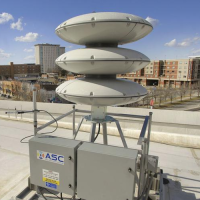 A newer ASC i-FORCE STi-1600, located on a rooftop. | |
| Company | Alerting Communicators of America (formerly)
|
|---|---|
| Produced | 1992-2005 (Quadren)
2005-present (i-FORCE)
|
| Type | Omnidirectional Electronic |
| Sound output | 113-128 dB @ 100 ft |
| Wattage | 400-4800 W (Quadren)
400-3200 W (i-FORCE) |
| Voltage | 24 V DC |
| Preceded by | ACA Alertronic |
| Documentation | Manual Product sheet |
The i-FORCE, originally known as the Quadren, is a siren that has been produced by American Signal Corporation (formerly Alerting Communicators of America) since 1992. It is ACA/ASC's attempt to compete with Federal Signal's Modulator and Whelen's WPS-2800 and 2900 series of sirens and is easily the least common of the three. It is currently sold alongside ASC's E-Class and Clarity series of electronic sirens, as well as the mechanical Tempest series.
The i-FORCE began production in 1992 as the Quadren. The Quadren was created by Alerting Communicators of America shortly after their bankruptcy in 1992, just before the company was renamed to the American Signal Corporation. It was a part of ACA's Alertronic line of sirens. The siren would continue to be produced under the American Signal Corporation beginning in 1994, being renamed the i-FORCE. This article will refer to Quadren by its original name to prevent confusion with the i-FORCE currently produced today.
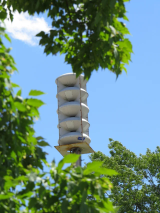
Quadren
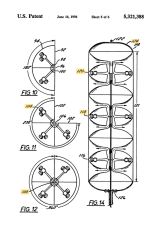
Released in 1992, the Quadren is a very unique siren designed to act as both a directional and an omnidirectional siren, whichever is required. While similar in appearance to a Modulator or a Whelen omnidirectional, its internal design is completely different. Unlike other stacked-cell sirens, the Quadren only has speaker compression drivers in every other cell, with the sound being projected out of both the top and bottom of each active cell using horns inside the cells. Each active cell has half of a dummy cell on the top and bottom which forms an entire dummy cell in between each active cell when stacked, which forms the projectors through its shape. Like all of ACA's sirens, the cells are made of weather and corrosion-resistant fiberglass. Each active cell quadrant has a removable panel to easily access and replace faulty drivers. Each active cell in a Quadren is formed by four separate quadrants, which when 4 of them are put together form an entire cell.

Each quadrant contains 4 100 W speaker compression drivers, meaning that a fully formed cell with 4 quadrants will have 16 100 W drivers. The siren was designed in a way where it could be cut in half or even in quarters to be mounted on walls or corners, instead of just on a pole. This made them more versatile, and they could be installed just about anywhere. Unfortunately, none of these wall or corner mounted Quadrens are known to have been installed or exist today. Up to three active cells were supported per siren, for a maximum of 4800 W. Variants with only a single output channel were also available, which only had one horn channel per cell and produced sound from only the bottom of the active cell. This made it more compact and similar to its competitors. Both one and three-celled compact Quadrens are known to have been produced.
Quadren models were given the "Q-XXXX" designation (XXXX being the wattage) and the three main models sold were the Q-1600, Q-3200, and the Q-4800. No Q-4800 models are known to exist. Today, the original Quadren has become an extremely rare siren. Having never sold very many units in the first place, there now remains about 4 units left in existence, only one of which is currently known to be active. This unit is located in Thailand and is a Q-1600. The other remaining units are two Q-1600 units in Kingsport, TN (one of which is the rare compact version). Two Quadren Q-3200 units once served in Mt. Prospect, IL until their replacement by Tempest-128s in 2022-2023.
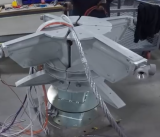
i-FORCE
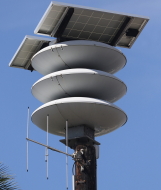
The Quadren would be sold until 2005, when it was redesigned to its current form, the ASC i-FORCE. The four-quadrant construction was kept, though the option to order the siren in 1, 2 and 3 quadrant cells was not carried over. Each active cell still contains 8 Atlas 100 W speaker compression drivers (two on each side), with a "dummy" bottom cell that projects the sound from the lowest active cell. The sound is now only channeled downwards, rather than out of both the top and bottom of the cell. The cells themselves have been slimmed down significantly, and no longer have walls dividing the quadrants. This design is much simpler, and less costly to produce. The sound is output from four "horns", one from each quadrant. The i-FORCE is significantly larger per cell than its Federal Signal and Whelen competitors, with the four-celled STi-2400 standing taller than an average man.
Early i-FORCE units were smooth, with the cells held together by bolts driven into a flange around the diameter of the cells. The flange covers the gap between the two halves of a cell, which gives early i-FORCES their seamless, smooth appearance. The flange was later removed, and the cells are now bolted together vertically which necessitates adding rounded indents into the cells to make room for the bolts. This was likely to simplify production and results in a highly visible line on the middle of each cell. The i-FORCE is available with up to 4 800 W active cells, for a total of 3200 W. There are 4 models available, the STi-800, STi-1600, STi-2400, and STi-3200. ASC also refers to these sirens as simply the i-FORCE 800, 1600, 2400, and 3200. The i-FORCE runs on 24 V DC and is voice and battery backup capable.
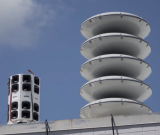
| Model | dB @ 100 ft | Number of drivers | Number of active cells |
|---|---|---|---|
| STi-800/i-FORCE 800 | 113 dB | 8 | 1 |
| STi-1600/i-FORCE 1600 | 118 dB | 16 | 2 |
| STi-2400/i-FORCE 2400 | 121 dB | 24 | 3 |
| STi-3200/i-FORCE 3200 | 128 dB | 32 | 4 |
The i-FORCE continues to be sold to this day and is the least popular out of the stacked-cell electronic sirens. However, it still performs strongly, and ASC appears to be hard at work improving upon the design according to teasers from the company itself. It is greatly outsold by its cheaper alternative, the E-Class, as well as ASC's various Tempest mechanical sirens.